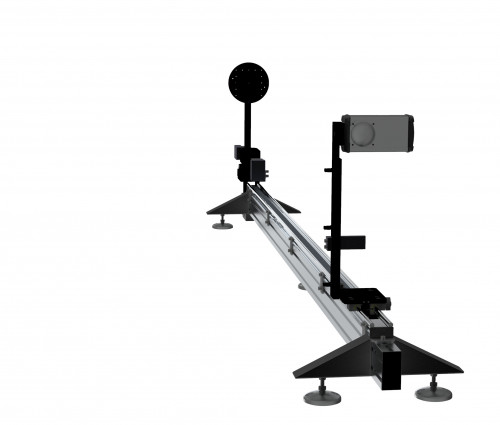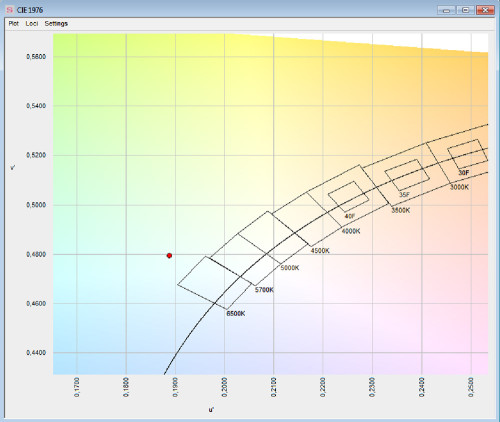该产品已停产。可能仍有剩余库存。请参阅下面 "类似产品 "下的替代产品或直接联系我们
此停产产品的替代产品:
GB-GD-360-RB40-2-BTS256-LED
Goniometer system for the luminous flux and light color measurement of individual 2π light emitting diodes with BTS256-LED
- Adjustable measurement distance up to 2000 mm
- Compact Goniometer
- Spectral light meter with Bi-Tec sensor for accurate measurement of the luminous flux, spectral radiant power, CCT, CRI, chromaticity coordinates, IES, EULUMDAT, etc.

Measurement of the luminous intensity distribution
Luminous intensity distribution is used to specify the directional radiation characteristics of lamps. It is determined by numerous separate measurements of the luminous intensity. Every measurement detects the light emitted into the half space around the lamp under a different viewing angle. The measurement data are represented in polar plots and 3D graphs and output in standard formats e.g., IES, EULUMDAT, Excel, etc. This data can also be used to calculate the luminous flux.
The BTS256-LED light meter
In its standalone mode, the compact BTS256-LED meter is designed for the convenient measurement of luminous flux, spectrum, color, and color rendering index of single LEDs. A key feature is the conical measurement port at the entry of the internal integrating sphere which enables the measurement of onboard LEDs. The bayonet connector used to attach the conical adapter makes it possible to combine the BTS256-LED with other accessory components. Gigahertz-Optik offers different accessories as part of the BTS256-LED Plus Concept which greatly extends the measurement capabilities of the BTS256-LED. These include the BTS256-LED-DA diffusor window which facilitates illuminance and luminous intensity measurements.
Enhancement of the BTS256-LED using the GB-GD-360-RB40-2 goniometer
The BTS256-LED-DA spectroradiometer can be combined with the GB-GD-360-RB40-2 goniometer in order to measure luminous intensity distributions. Unlike other diode array spectrometers that are available on the market, the BiTec sensor of the BTS256-LED offers the option to perform the measurement with just its photometric photodiode. Its short measurement times allow for measurements that are much faster than conventional spectrometers. In cases where spectrum, color, and color rendering index are also needed, the array-based spectrometer of the BiTec sensor may be employed. The GB-GD-360-RB40-2 goniometer allows for the alignment of the test lamp to the device with two degrees of freedom. The rotary movements are controlled remotely via stepper motor drives. The turntable has an M4 holes arrangement for universal attachment of the test lamps. Four mini-sockets provide four-terminal connection. The turntable enables fine tuning with 5 mm stroke and a coarse tuning with 100 mm stroke for alignment of test lamps in the goniometric axis. A removable stop is integrated to aid the alignment of the test lamp in the goniometric axis. The distance between the device and the test lamp can be varied between 100 mm and 2000 mm. The short distance is chosen for measurement of single LEDs with low intensity. The longer distance is better suited for measurement of extended LED arrays and LED lamps. The broad dynamic range of the GB-GD-360-RB40-2-BTS2048-VL makes it better suited for measurement of spot lamps that have a distinctive edge profile. The rail on the guide carriage is stiffened with a stable base. The BTS256-LED and BTS256-LED-DA can also be used without the goniometer.
Software
The S-BTS256 user software supports operation of the goniometer and display of measurement values. It can be used to create measurement sequences as well as configure different settings. The measurement data can be exported to standard formats such as IES, EULUMDAT, ASCII, and Excel. Besides the display of the luminous intensity distribution in polar graphs and 3D plots, the software can also be used to calculate the luminous flux as well as display the spectrum, color values, etc.
Calibration
One essential quality feature of photometric devices is their precise and traceable calibration. The BTS256-LED-DA is calibrated by Gigahertz-Optik’s calibration laboratory that is accredited by DAkkS (D-K-15047-01-00) for the spectral responsivity and spectral irradiance according to ISO/IEC 17025. The calibration also included the corresponding accessory components. Every device is delivered with its respective calibration certificate.

BTS256-LED spectroradiometer with the GB-GD-360-RB40-2 goniometer

Display of the luminous intensity distribution in a polar diagram

Display of the luminous intensity distribution in a 3D diagram

BTS256-LED for measurement of the luminous flux, spectrum, color, and color rendering index of single LEDs

The S-BTS256 user software supports measurement and display of the luminous intensity distribution curve in 2D and 3D.

Full screen display of the luminous spectrum

CIE 1976 chromaticity diagram with binning fields
类似产品/Similar Products
